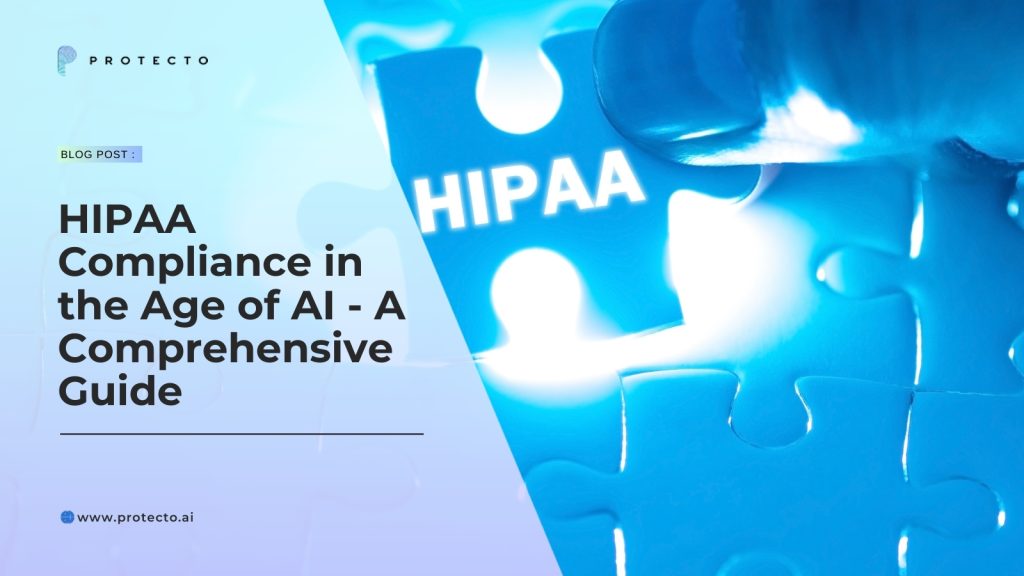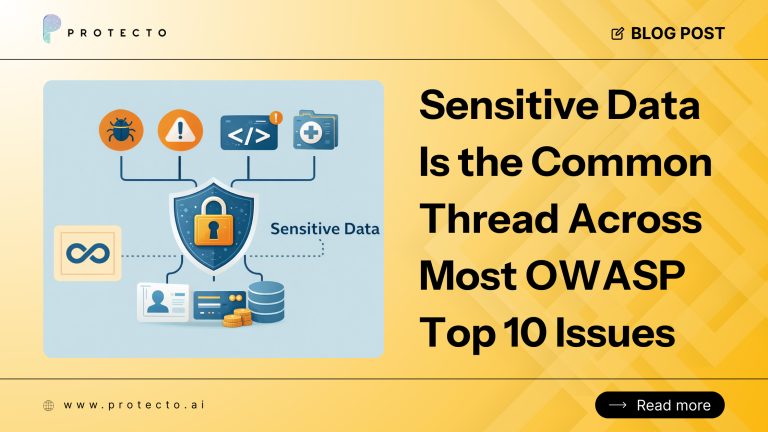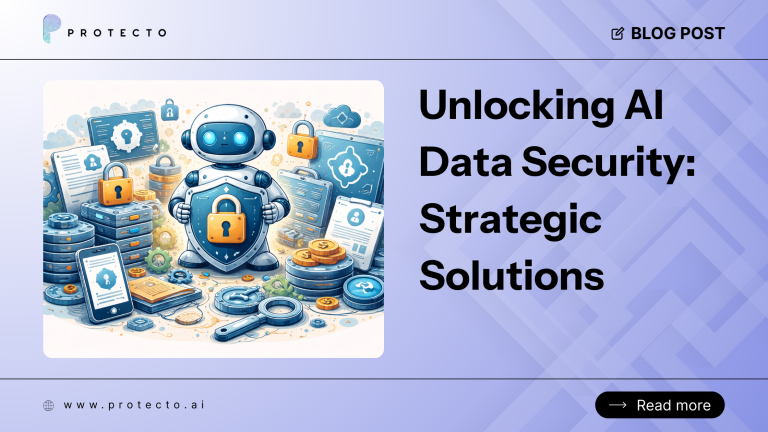The healthcare landscape is undergoing a transformative journey as it intersects with the mighty realm of artificial intelligence (AI). This comprehensive guide navigates the intricate dance between compliance with the Health Insurance Portability and Accountability Act (HIPAA) and the increasing integration of AI in healthcare.
In the evolving tapestry of medical practices, AI emerges as a pivotal player, influencing patient care and administrative processes. Here, we look at the synergies and challenges posed by the intersection of HIPAA and AI, setting the stage for a journey through the fundamental principles, intricacies of compliance, and evolving responsibilities in this dynamic era.
As AI takes center stage in healthcare, exploring its growing role becomes imperative. From diagnostic assistance shaping personalized treatment plans to the streamlined efficiency of administrative processes, AI is reshaping the very foundations of healthcare delivery. Join us on a comprehensive exploration of HIPAA compliance in the age of AI, where innovation meets regulation for a harmonious future in healthcare.
Evolving Healthcare Landscape
In the dynamic intersection of healthcare and AI, AI’s integration into patient care goes beyond mere augmentation; it fundamentally reshapes diagnostic processes and treatment plans, fostering a new era of precision medicine.
Within patient care, AI assumes a pivotal role in diagnostic assistance. Machine learning algorithms analyze vast datasets, aiding healthcare professionals in accurate and timely diagnoses. Whether identifying subtle anomalies in medical imaging or discerning patterns in patient data, AI becomes a powerful ally, enhancing the accuracy and efficiency of medical diagnoses.
Moreover, the influence of AI extends to the personalized realm of treatment plans. Healthcare providers can tailor treatments using sophisticated algorithms based on individual patient data, optimizing outcomes and minimizing adverse effects. This customized approach represents a paradigm shift in healthcare, aligning treatments with the unique characteristics of each patient.
Beyond patient care, AI applications permeate administrative processes, ushering in operational efficiencies and robust data management. Streamlining operations involves automating routine tasks, reducing administrative burdens, and freeing healthcare professionals to focus more on patient-centric activities. Concurrently, AI is crucial in enhancing data management, ensuring the secure and efficient handling of vast healthcare datasets.
HIPAA Fundamentals
Navigating the intersection of AI and healthcare demands a comprehensive understanding of the fundamental principles outlined by HIPAA. As the backbone of healthcare data security and privacy, HIPAA sets the stage for responsible AI integration within the healthcare landscape.
Brief Overview of HIPAA
HIPAA, enacted in 1996, safeguards patient information, ensuring its confidentiality, integrity, and availability. The primary goal is to balance the seamless exchange of healthcare information and protect patients’ sensitive data.
Core Components Relevant to AI Integration
Privacy Rule: The Privacy Rule establishes standards to effectively protect individuals’ medical records and personal health information. Adherence to these standards is paramount in AI to preserve patient privacy during data processing and analysis.
Security Rule: The Security Rule complements the Privacy Rule by focusing on the technical and physical safeguards necessary to ensure the integrity and security of electronic protected health information (ePHI). AI integration requires a meticulous approach to align with these security standards.
Breach Notification Rule: The Breach Notification Rule mandates that covered entities promptly notify affected individuals, the Department of Health and Human Services (HHS), and, in some instances, the media, in the event of a data breach. This rule becomes particularly crucial as AI applications handle vast amounts of sensitive health data.
Navigating HIPAA Compliance Challenges in AI
As healthcare embraces AI technologies, organizations face unique challenges in aligning AI practices with HIPAA compliance. The dynamic nature of AI algorithms and the potential scale of data processing necessitate ongoing efforts to ensure that AI applications adhere to the intricate requirements of HIPAA. Addressing these challenges requires a proactive approach, combining technological advancements with a deep understanding of HIPAA’s core tenets.
HIPAA Privacy Rule and AI
In the interplay between healthcare and artificial intelligence, the HIPAA Privacy Rule takes center stage, dictating the careful handling of Protected Health Information (PHI) within AI systems. As AI increasingly becomes a cornerstone of healthcare innovation, navigating the nuances of consent, authorization, and individual rights becomes paramount.
Within AI-driven healthcare, the challenge lies in harmonizing AI’s dynamic capabilities with the rigid HIPAA Privacy Rule requirements. It mandates a meticulous approach to PHI, ensuring that patient information is treated with the highest regard for privacy. Consent and authorization mechanisms in AI processes must align with HIPAA standards, fostering a delicate balance between leveraging patient data for advancements and safeguarding individual privacy rights.
Individual rights within the realm of AI processing demand special attention. As AI algorithms crunch vast datasets to inform diagnostics and treatment plans, patients retain the right to understand and control how their health information is utilized.
HIPAA Security Rule and AI
In balancing healthcare and AI, the HIPAA Security Rule emerges as a crucial partner, ensuring the safeguarding ePHI in AI environments.
- Technical Safeguards for AI Systems: AI systems, being dynamic and data-intensive, necessitate robust technical safeguards. Encryption of ePHI, access controls, and audit controls become paramount. Robust authentication procedures ensure that only authorized personnel access sensitive health information, aligning with HIPAA’s security principles.
- Ensuring Physical and Administrative Safeguards: Beyond the digital realm, the Security Rule extends its reach to physical and administrative safeguards. This involves securing the physical infrastructure housing AI systems to prevent unauthorized access. Organizational measures include comprehensive risk assessments and management, ensuring that potential vulnerabilities in AI implementations are identified and addressed systematically.
- Adapting Security Measures to AI’s Dynamic Nature: AI’s ever-evolving landscape demands a proactive approach to security. Continuous monitoring, regular risk assessments, and adaptive security measures are essential.
HIPAA Enforcement in the Age of AI
The Office for Civil Rights (OCR) plays a crucial role in overseeing and enforcing HIPAA regulations, adapting to the complexities introduced by AI integration.
The OCR’s responsibility is to monitor and enforce compliance in AI-driven healthcare environments. This involves conducting audits and investigations to assess how entities handle PHI within AI systems. As AI evolves, the OCR’s role becomes increasingly significant in safeguarding patient privacy and data security.
Non-compliance in AI-driven environments carries substantial penalties, emphasizing the gravity of adhering to HIPAA regulations. Entities must navigate the intricate landscape of audits, investigations, and potential repercussions for any violations. As healthcare embraces the transformative power of AI, the OCR’s vigilance ensures that advancements align with HIPAA standards, reinforcing trust in the responsible use of technology for patient welfare.
HIPAA Compliance Checklist for AI Integration
Consider this comprehensive checklist to assess and manage AI-related risks while fostering responsible AI use.
- Assessing and Managing AI-Related Risks: Conduct a thorough risk assessment tailored to the specificities of AI applications. Identify potential risks associated with AI-driven processes, including data breaches, unauthorized access, and system vulnerabilities. Develop a versatile risk management plan that outlines preventive measures and response strategies.
- Developing Policies for Responsible AI Use: Craft clear and concise policies addressing the responsible use of AI in compliance with HIPAA regulations. Define guidelines for handling patient data, ensuring transparency, and safeguarding against privacy breaches. Clearly articulate the roles and responsibilities of healthcare professionals and AI system operators in maintaining compliance.
- Employee Training on AI and HIPAA Compliance: Empower healthcare staff with comprehensive training on the intersection of AI and HIPAA compliance. Ensure that employees understand the nuances of AI applications, potential risks, and the importance of adhering to HIPAA regulations. Continuous education programs can help staff stay abreast of evolving compliance standards and technological advancements.
AI’s Impact on HIPAA Digital Security
Where healthcare and AI converge, digital security becomes paramount. As healthcare systems embrace AI technologies, safeguarding against potential threats and vulnerabilities takes center stage.
Cybersecurity Measures for AI Systems
AI introduces a paradigm shift in the healthcare cybersecurity landscape. Implementing robust cybersecurity measures becomes imperative to protect patient data, especially considering the dynamic nature of AI applications. Encryption, access controls, and secure data transmission mechanisms ensure the confidentiality and integrity of any healthcare information processed by AI.
Safeguarding Against AI-Specific Threat Vectors
As AI evolves, so do the threat vectors. AI-specific vulnerabilities, therefore, pose a unique challenge. It encompasses strategies to safeguard against adversarial attacks, bias exploitation, and other emerging threats tailored to exploit the intricacies of AI algorithms. Healthcare entities must anticipate and proactively address these threats to uphold patient data integrity.
AI-Driven Security Innovations
While AI introduces challenges, it also serves as a potent ally in enhancing digital security. This part discusses how AI-driven innovations contribute to threat detection, anomaly identification, and predictive analytics. Leveraging AI for continuous monitoring and adaptive security measures aligns with HIPAA’s call for a proactive stance against evolving cybersecurity threats.
Final Thoughts
This exploration of the intricate dance between HIPAA and AI in healthcare makes it evident that comprehensive compliance measures are paramount. The evolving landscape, where Artificial Intelligence integrates seamlessly into patient care and administrative processes, demands a vigilant approach to safeguarding sensitive health information.
As we navigate the nuances of the HIPAA Privacy and Security Rules in the age of AI, it is clear that adapting security measures to AI’s dynamic nature is imperative. The enforcement landscape, led by the Office for Civil Rights, underscores the gravity of compliance, with audits and penalties shaping the regulatory terrain.
Continuous education and adaptation are the cornerstones of navigating the ever-evolving intersection of healthcare compliance and artificial intelligence. It is also important for organizations to embrace the right tools, such as Protecto. Protecto can help organizations with meeting the rigorous demands of compliance with an extensive feature set that provides important functionality to interact with AI systems without exposing sensitive data.



